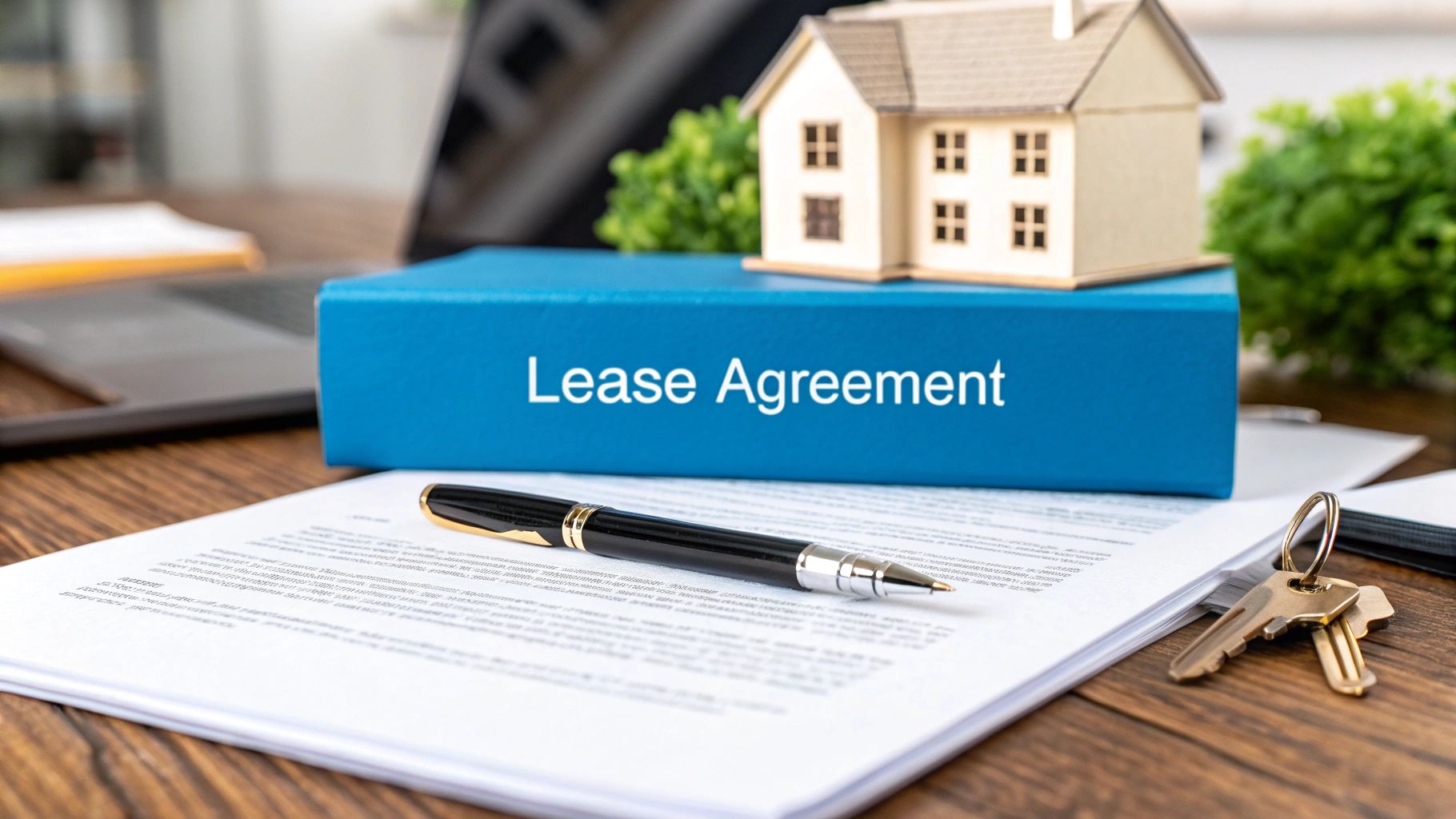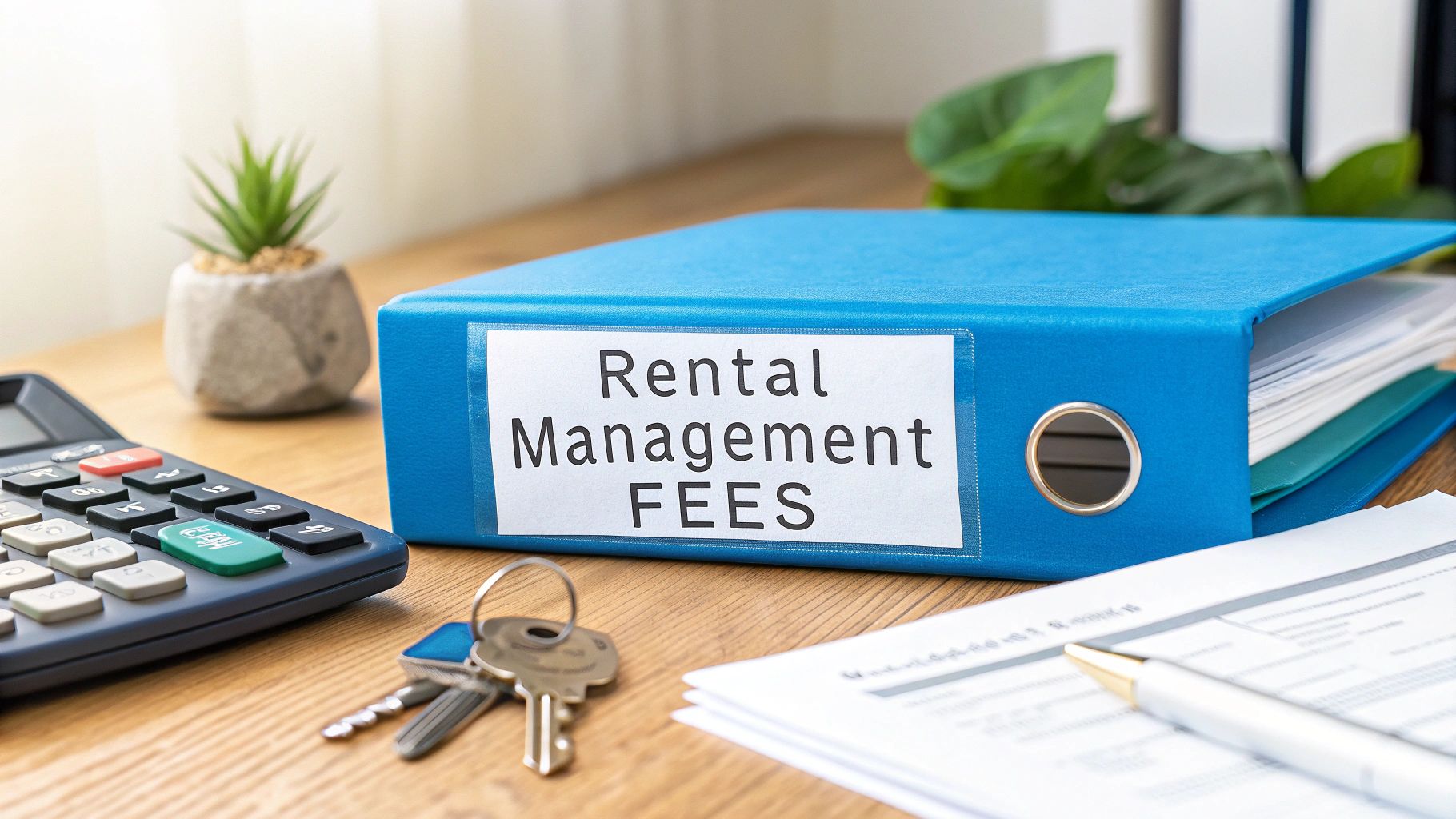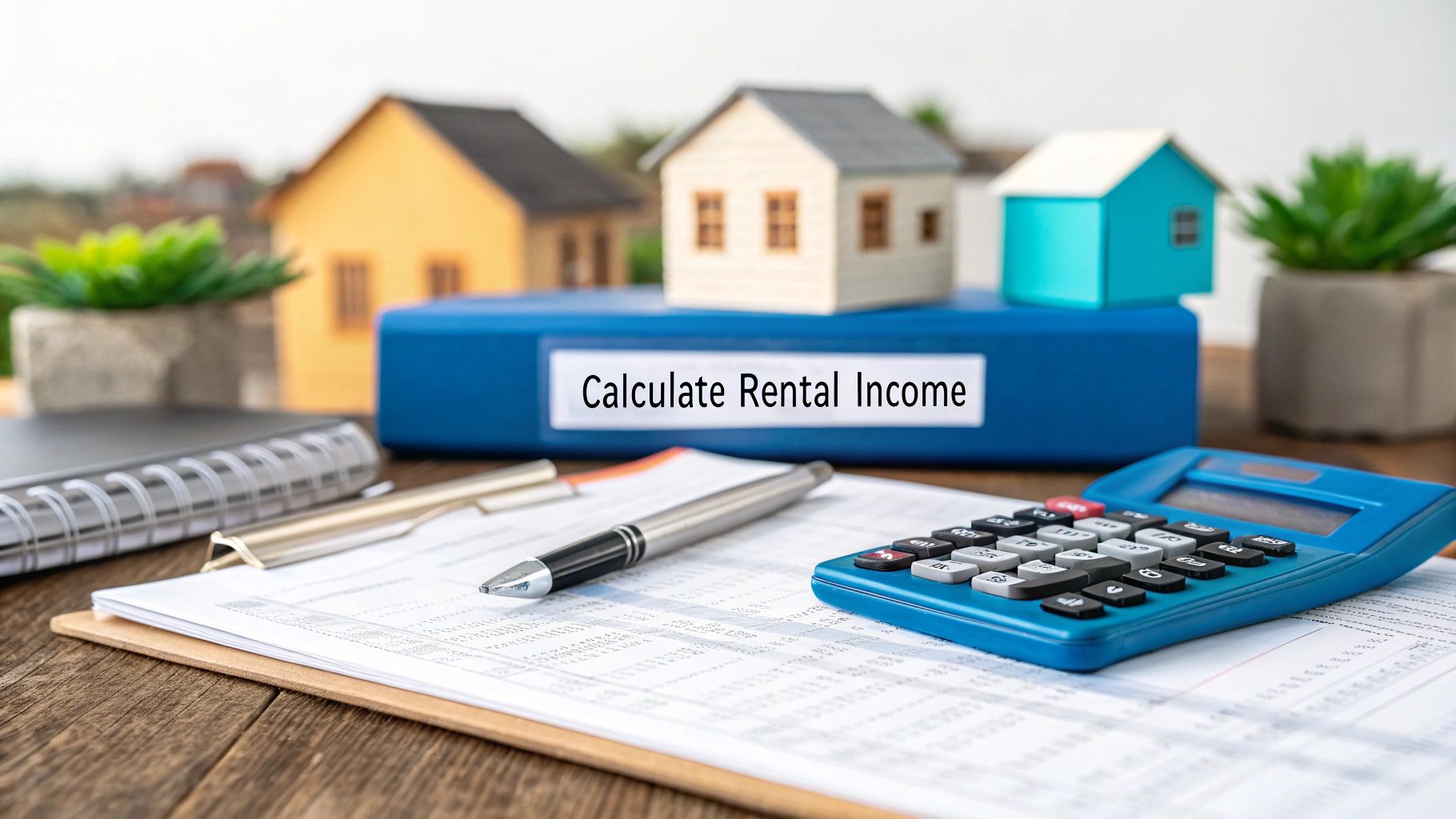For a property management company looking to scale, a lease agreement is so much more than a simple contract. It’s the operational blueprint for your entire portfolio. When you’re managing hundreds—or even thousands—of properties, the lease becomes the single most important tool for standardizing every tenant relationship, driving operational efficiency, and protecting your assets from risk.

A Strategic Tool for Portfolio Management
Think of your lease agreement as the central operating system for your portfolio. It’s not just a legal document; it’s a strategic asset built to drive efficiency, maintain compliance across different markets, and lock in your revenue. A well-designed lease has a direct impact on your most critical KPIs, such as Days on Market (DOM) and cost per door, because it standardizes the core processes that make or break remote operations.
Every day a unit sits vacant, you’re losing revenue. A solid lease is the final step in converting a qualified lead and stopping that clock. It formalizes the terms that turn a promising applicant into a paying tenant, bringing your DOM to zero. By setting clear expectations from the start, you also mitigate future disputes that could lead to costly vacancies down the road.
To truly understand its role, let's look at how a standardized lease serves as a core tool for scalability.
Lease Agreement Core Functions for Scalability
In short, the lease agreement is the architecture that allows a property management business to grow without collapsing under its own weight.
Standardizing Operations at Scale
Trying to manage a portfolio of 1,000+ units without a standardized lease would be chaos. A uniform agreement ensures that every single team member, whether they’re in-house or working remotely, follows the exact same playbook. This consistency is absolutely essential for remote-first property management.
Here’s where it makes a real difference to your bottom line:
- Streamlining Rent Collection: Your lease can mandate electronic payments and outline a strict late fee policy, automating collections and making your cash flow far more predictable.
- Clarifying Maintenance Responsibilities: It draws a clear line between tenant-reported issues and owner obligations. This simple step cuts down on unnecessary maintenance calls and lowers your operational cost per door.
- Enforcing Rules and Regulations: When the rules are the same everywhere, enforcement becomes simpler and your legal exposure shrinks. It creates a fair and consistent experience for all tenants.
- Ensuring Multi-Market Compliance: You can build a master lease that is easily adapted with state-specific addenda. This means you’re always legally compliant without having to reinvent the document for each new market.
The Foundation of a Strong Landlord-Tenant Relationship
At the end of the day, a lease is what the entire landlord-tenant relationship is built on. It sets clear, legally binding expectations for everyone involved, which goes a long way in preventing the misunderstandings that lead to disputes, bad online reviews, or tenants breaking their lease early.
Of course, a strong lease only works if you have a reliable tenant. That's why the process starts with thorough screening to ensure you're bringing qualified renters into your properties. For a deeper dive into this crucial first step, this landlord's guide to tenant background checks is a fantastic resource.
When you pair a well-vetted tenant with a rock-solid lease, you create a formula for predictable revenue and operational stability—the two things you need to successfully scale your portfolio.
The Anatomy of an Ironclad Lease Agreement
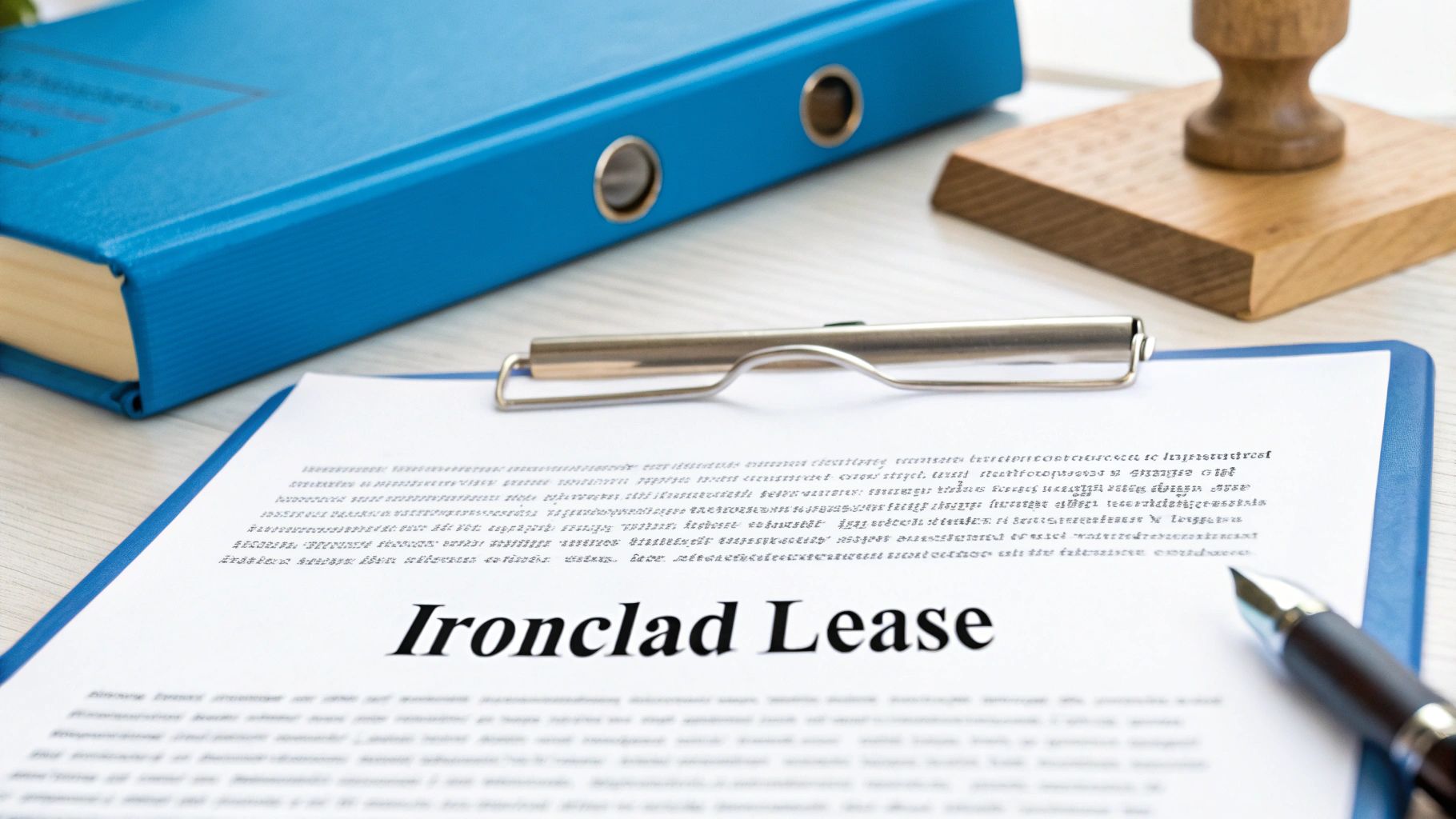
When you’re managing properties at scale, a lease agreement stops being a simple formality and becomes your operational control panel. A generic, off-the-shelf template just won’t cut it when you’re dealing with hundreds of units spread across different cities or states. A truly ironclad lease is engineered to protect your assets, lock in your cash flow, and set enforceable standards across your entire portfolio.
Let's break down the non-negotiable parts that turn a basic contract into a strategic weapon for portfolio management. These are the levers you need to pull to cut down on legal risks, boost efficiency, and keep revenue predictable.
Core Financial and Legal Safeguards
At its heart, a lease needs to spell out the money and the rules, no ambiguity allowed. These clauses are your first line of defense against lost rent and messy disputes. Without them, you’re just running on assumptions—a recipe for disaster when you're managing more than a handful of properties.
These foundational elements include:
- Parties Involved: Clearly name the landlord (or your property management company as the agent) and every single tenant responsible for holding up their end of the deal. This is absolutely critical for enforcement actions.
- Property Description: An exact address and description of the rental unit, right down to the assigned parking spot or storage unit. Fuzzy details here are a breeding ground for conflict.
- Lease Term: Pinpoint the exact start and end dates for a fixed-term lease or lay out the rules for a month-to-month tenancy. This data is the bedrock of accurate revenue forecasting and turnover management.
The Engine of Your Cash Flow: Rent and Deposits
How you structure the rent and security deposit clauses directly fuels your company's financial health. For large portfolios, optimizing these terms for speed and compliance isn't just a good idea—it's essential. It’s all about getting paid on time, every time, while navigating a tangled web of state and local laws.
Landlord-tenant law can be notoriously complex. For example, some jurisdictions require interest to be paid on security deposits, while others have strict caps on late fees. Your standardized lease has to be robust enough to handle these variations through state-specific addenda.
This is exactly why your lease must precisely outline:
- Rent Payment Terms: This clause should demand electronic payments through an online portal or ACH to accelerate collections and slash manual processing. It also needs to clearly state the exact rent amount, the due date, and any grace period.
- Late Fee Structure: Define the penalty for late payments, making sure it’s fully compliant with state and local caps. A standardized, automated late fee process is one of the best ways to encourage on-time payments.
- Security Deposit Rules: Detail the deposit amount, where the funds will be held, and the specific conditions for making deductions. This is a minefield of regulations, and a compliant clause is your best defense against costly legal challenges, especially when operating across multiple states.
Operational Clauses for Remote Management
Beyond the money, an ironclad lease sets the day-to-day rules of the game. These operational clauses are what give your remote teams the power to manage properties effectively without needing to be onsite 24/7. They create a clear, repeatable system for handling the most common issues that pop up.
Think about the impact of these critical components:
- Maintenance and Repairs: This clearly separates tenant and landlord responsibilities. The clause should map out the exact process for submitting maintenance requests (e.g., via an online portal), which helps prevent needless service calls and ends the "who pays for what" debate.
- Right of Entry: This legally defines when and how you can enter the property for inspections, repairs, or showings. A well-written clause ensures you can access units when needed—which is crucial for cutting down Days on Market (DOM)—while still respecting tenant privacy laws.
- Use of Premises and Rules: Set clear guidelines on everything from occupancy limits and guest policies to noise restrictions and property alterations. This standardization makes enforcement a breeze and ensures a consistent living experience for all tenants, which helps protect property values across your whole portfolio.
Each of these components fits together to create a single document that acts as your remote operations manual. It’s the framework that lets you manage a thousand properties with the same control and consistency as a portfolio of ten.
Operational Clauses That Drive Portfolio Efficiency
While financial and legal clauses form the backbone, operational clauses are where you can unlock significant efficiencies for a scaling portfolio. These are the sections that manage the day-to-day, prevent minor annoyances from becoming major problems, and empower your team to resolve issues by referencing the contract. For property managers overseeing a large portfolio, this kind of standardization isn't a "nice-to-have"—it's the only way to reduce operational friction and lower your cost-per-door.
Think of a great lease as a preemptive problem-solver. It anticipates common questions and disputes and addresses them before they arise. This dramatically reduces the time-consuming back-and-forth that plagues property managers, freeing up your team to focus on scalable growth.
Clarifying Maintenance and Repair Protocols
Nothing creates tension and wasted time like fuzzy maintenance rules. A well-written clause gets everyone on the same page from day one, protecting the property and your profits.
Your lease should clearly spell out:
- Tenant Responsibilities: Lay out the small stuff tenants handle, like swapping out light bulbs or air filters. This simple step cuts out a surprising number of pointless and expensive service calls.
- Landlord Obligations: Make it crystal clear what’s on your plate—think HVAC, major plumbing, or structural fixes. This sets realistic expectations from the get-go.
- Reporting Procedures: Insist that all non-emergency requests come through an online portal. This gives you a documented, easy-to-track paper trail for your entire team.
This simple structure kills the guesswork. It ensures every request gets handled the same way, whether you're managing 100 doors or 10,000.
Defining the Right of Entry
For any property management company obsessed with keeping vacancy low, the right of entry clause is a game-changer. This is what gives you the legal green light to get into a property for showings, inspections, and repairs while still respecting the tenant's privacy. A solid right-of-entry clause is absolutely critical for shrinking your Days on Market (DOM) because it lets your team show a property to new prospects before the old tenant has even moved out.
Why does this matter so much? According to Zillow, the median rent in the U.S. was $1,987 as of June 2024. This means every vacant day costs the average property owner over $65 in lost revenue. For a 1,000-unit portfolio with a national average vacancy rate of 6.6%, the revenue impact is substantial. Reducing DOM by even a few days per unit translates directly to tens of thousands of dollars in reclaimed revenue.
Standardizing Rules and Regulations
A detailed "Rules and Regulations" section is your secret weapon for creating a consistent living experience across your entire portfolio. This is where you get ahead of potential problems before they ever start.
A standardized lease is the only way to ensure that a tenant in one state has the same core experience as a tenant a thousand miles away. This consistency is the foundation of a scalable and defensible property management operation.
Make sure this section covers the big ones:
- Occupancy Limits: State the maximum number of residents to prevent unauthorized people from moving in.
- Guest Policies: Define how long a guest can stay before they’re considered an unvetted tenant.
- Property Alterations: Forbid unauthorized changes like painting or installing new fixtures to protect the property’s condition.
- Noise and Nuisance: Set clear quiet hours and rules for common areas to keep the peace between neighbors.
By putting these rules in writing, you give your team a clear standard to enforce. Instead of making judgment calls, they can point to a specific clause in a legal document. This doesn't just make enforcement easier; it significantly lowers your company's legal risk.
To help you build a lease that truly works for a large-scale operation, here’s a quick-glance table of the most critical operational clauses.
Essential Operational Lease Clauses at a Glance
These are the clauses that move beyond basic legal protection and actively streamline your day-to-day operations. When implemented correctly, they form the bedrock of an efficient, scalable property management system.
These aren't just rules; they're system-builders. Tracking the efficiency gains from clauses like these is crucial, and you can dive deeper into the relevant KPIs with our guide on key leasing metrics. When you get them right, these operational clauses do more than just manage a property—they build a scalable machine for remote management.
Choosing the Right Lease Type for Your Assets
When you're managing a large portfolio, picking a lease type isn't just a small detail—it's a core strategic decision. The right lease can lock in revenue and keep your portfolio stable, while the wrong one can leave you with high turnover or, even worse, trap you in below-market rates as the area appreciates.
It’s all about matching the lease to both the property and the local market. Think of it as a financial tool you can use to optimize performance.
This decision has never been more critical. The global leasing industry has ballooned by about 76% over the last decade. Despite economic headwinds, new business volume still climbed 5.7% in 2023 alone, a testament to the sector's strength. You can dive deeper into these numbers in the Global Leasing Report.
Fixed-Term Leases for Revenue Predictability
For single-family rentals (SFR) and most multifamily properties, the 12-month fixed-term lease is the industry standard for a reason. Its greatest strength is predictability.
When you lock in a tenant for a year, you’re guaranteeing a steady stream of income. This makes financial forecasting a whole lot easier, whether you’re planning for capital improvements or just managing day-to-day operational costs.
- Reduced Turnover Costs: Constant turnover is a huge drain on your budget. Each time a unit empties, you’re on the hook for marketing, showings, cleaning, repairs, and all the admin work that goes with it. Longer leases minimize this churn.
- Minimized Vacancy Loss: A guaranteed tenancy means fewer days the property sits empty. Across a portfolio of 1,000+ units, cutting vacancy by just a few days per unit can add up to hundreds of thousands of dollars in reclaimed revenue each year.
- Greater Tenant Investment: Tenants on a year-long lease tend to treat the property more like their own home. This often translates to better property care and fewer maintenance calls down the line.
Month-to-Month Agreements for Strategic Flexibility
While fixed-term leases provide a safety net, month-to-month agreements give you something equally valuable: flexibility. In certain situations, this is exactly what you need.
If you have properties in a hot market where rents are climbing fast, a month-to-month lease lets you adjust rates more often so you don't get stuck with an undervalued property for an entire year.
This type of lease is also perfect if you're thinking about selling a property or have major renovations planned. It gives you the agility to end the tenancy with proper notice, avoiding the legal headaches of breaking a long-term contract.
For a portfolio manager, the decision isn't about which lease is "better," but which is the right tool for the job. A fixed-term lease is a shield, protecting revenue. A month-to-month lease is a scalpel, allowing for precise adjustments in volatile conditions.
This decision tree shows how a clear lease can guide property managers toward resolving common issues like maintenance or property access.
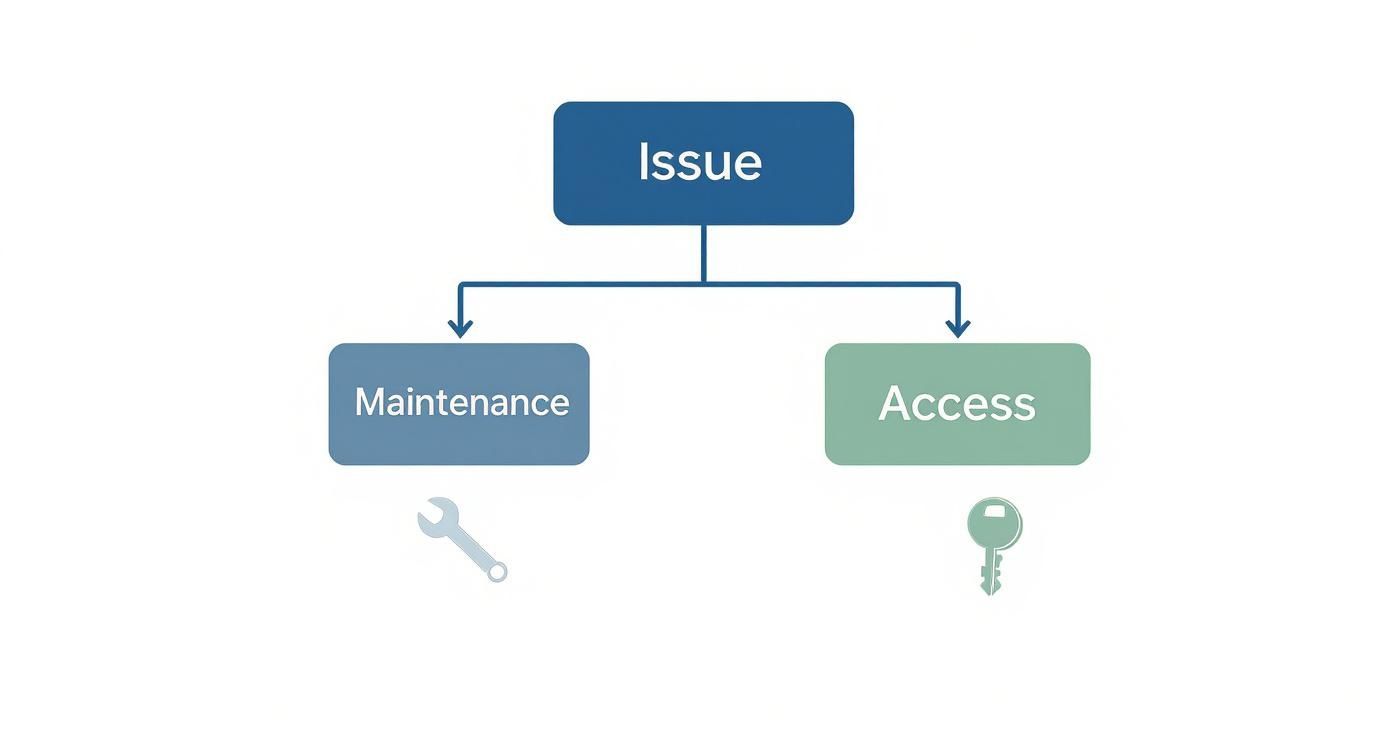
As you can see, a well-drafted lease provides a clear roadmap for handling the most frequent operational hiccups, from a simple repair request to needing to enter the property.
Ultimately, the smartest approach is often a blended one. Use fixed-term leases for the bulk of your portfolio to ensure stability, but keep month-to-month agreements in your back pocket for specific properties that need more flexibility. This balanced strategy lets you hedge against market swings while still maximizing performance across your entire portfolio.
A Scalable Framework for Lease Enforcement
When you're managing thousands of units, enforcing lease terms isn't just about handling one-off issues. It's about building a system that's consistent, fair, and most importantly, scalable. One slip-up or inconsistent action can put your entire operation at legal risk and tell tenants that your lease agreement is just a suggestion.
For property managers overseeing a large portfolio, a solid enforcement framework protects the owner's investment and keeps your operations running smoothly. It ensures every violation—from late rent to an unauthorized paint job—is handled with the exact same protocol, every single time. This turns enforcement from a reactive headache into a predictable, documented, and legally sound process.
The real goal here isn't to punish tenants; it's to correct behavior and get back to compliance.
Documenting and Verifying Violations
Before you send a notice or charge a fine, you need cold, hard proof. The first step in any enforcement action is meticulous, objective documentation. This removes all subjectivity and gives you a firm foundation if things escalate.
- For Late Rent: Your property management software is your best friend. It should automatically log the exact date and time of non-payment, creating a digital record that serves as your primary evidence.
- For Unauthorized Alterations or Damages: Time-stamped photos and videos from inspections are non-negotiable. This is the visual proof you need to show a violation occurred.
- For Noise Complaints: Document the date, time, and specific details of every complaint. A single incident might be a fluke, but a documented pattern of disturbances is powerful evidence.
This standardized approach is a lifesaver for remote teams. A portfolio manager in a central office can review the evidence and approve the next steps with total confidence, knowing the facts on the ground are accurately recorded.
Issuing Compliant Notices
Once you've verified a violation, it's time to issue a formal notice. This step has to be done by the book, strictly following your state and local landlord-tenant laws. These laws get very specific about the type of notice, how it must be delivered, and the timeline the tenant has to "cure" (or fix) the issue.
A classic mistake growing property management companies make is treating notices informally. If a notice is delivered improperly, a court could rule it invalid. That means you have to start the entire process over, losing valuable time and money.
To keep things compliant at scale, work with an attorney to create standardized templates for common violations. Think a "Notice to Pay or Quit" for late rent or a "Notice to Cure or Quit" for breaking a rule. This takes the guesswork out of it for your team and ensures every notice you send is legally solid.
Managing Escalations and Resolutions
So what happens if a tenant ignores the notice and doesn't fix the problem? Your framework should have a clear, pre-defined path for escalation. This might mean assessing a fine (as laid out in the lease), getting your legal counsel involved, or moving toward eviction proceedings.
Having a well-defined escalation path ensures decisions are based on company protocol, not emotion. This structured approach is also vital for maintaining fairness and protecting your company’s reputation. When every tenant is treated according to the same clear rules, the process is transparent and easy to defend.
It all comes back to where you started: a strong lease paired with great tenants. To learn more about getting that first step right, check out our guide on prospect screening for ideal tenants. After all, consistent enforcement of a solid lease begins with choosing residents who will respect its terms from day one.
Ditch the Paperwork: Using Tech to Automate the Lease Lifecycle
Trying to manage leasing at scale with manual processes is a recipe for errors, inefficiency, and lost revenue. For large-scale portfolios, leveraging a modern PropTech stack isn't just an option; it's a necessity for turning the entire lease lifecycle into a smooth, automated workflow.

This isn't just about getting fancy software; it's about building a low-touch, high-efficiency leasing machine. The impact on key metrics—like your cost-per-door and speed-to-lease—is huge. It frees up your team to focus on growing the portfolio instead of getting buried in paperwork.
From Generation to E-Signature
The automation journey starts the moment a lease needs to be created. Modern property management software (PMS) can auto-generate compliant lease agreements using templates your attorney has already vetted. These systems pull applicant data straight from your records, which means no more manual data entry and a much lower risk of costly typos.
Once the lease is generated, it’s sent out for an e-signature. This step alone can shave days off your leasing timeline. Instead of the old-school print, sign, scan, and email routine, tenants can sign the agreement on their phone in minutes. Getting this done fast is critical for minimizing vacancy loss and locking in that revenue.
Automating lease execution smashes the biggest bottlenecks in the process. This has a direct impact on your Days on Market (DOM), turning an approved applicant into a paying tenant in hours, not days. You secure the asset and stop the clock on lost rent.
Centralized Management and Renewal Automation
Once the lease is signed, technology steps in as your command center. Every lease in your portfolio is stored securely in one digital hub, making it instantly accessible and auditable. No more worrying about lost files or damage—a must-have for remote teams managing properties across different cities.
But it doesn't stop there. Automation keeps working throughout the entire lease term. Here are a few tasks technology can take off your plate:
- Automated Reminders: Your system can send out automatic pings for upcoming rent payments, lease expirations, and renewal deadlines.
- Renewal Workflows: When a lease is about to expire, the software can kick off a renewal workflow, sending offers and tracking who has responded without you lifting a finger.
- Compliance Tracking: Good systems help you keep tabs on critical dates and clauses, ensuring you stay compliant with local and state laws across a diverse portfolio.
This shift toward tech isn't a small trend. The lease management market, valued at USD 4.97 billion, is expected to jump to USD 7.62 billion by 2032, all because property managers need standardized, compliant ways to operate. You can read the full market research to see the data behind this growth.
Tools like AI leasing assistants can tighten up these processes even more by handling initial inquiries and pre-qualifying leads, so your team only spends time on the best prospects. To see what that looks like in the real world, learn more about the benefits of using an AI leasing assistant in our guide. By weaving automation into every stage, you build a leasing operation that’s scalable, efficient, and profitable.
Got Questions About Leases? We've Got Answers.
When you're managing a mountain of leases, you need clear, straightforward answers. Here are the solutions to the most common questions we see from property managers running large-scale operations.
How Often Should We Update Our Standard Lease Agreement?
Think of your lease agreement as a living document. Best practice is to give it a full review with your legal counsel once a year.
Why so often? Landlord-tenant laws are constantly shifting at both the state and local levels—sometimes changing more than once a year. An annual audit ensures your agreements are buttoned up and compliant, protecting your portfolio from nasty legal surprises. Of course, if a major new regulation drops, you'll want to huddle with your attorney right away to get your lease updated immediately.
What's the Smartest Way to Manage All Those Lease Addenda?
The only way to do this at scale without losing your mind is to use a centralized document management system. Ideally, this system should be built right into your property management software. Create a library of standardized, pre-approved templates for every common addendum you use—pets, mold, smart home devices, you name it.
This approach gives you absolute consistency across thousands of units. It also makes remote signing a breeze and allows for quick audits to see exactly which addenda are attached to any given lease, which is a lifesaver for compliance and enforcement.
What Are the Must-Haves for a "Breaking a Lease" Clause?
First and foremost, your lease needs an explicit early termination clause. This section should spell out the exact financial consequences for the tenant, whether it's a specific fee or forfeiting the security deposit. Critically, this clause has to be 100% compliant with your state and local laws.
Many states give tenants the legal right to break a lease without penalty under specific circumstances, like military deployment or being a victim of domestic violence. Your clause must account for these legal protections, or it won't be enforceable and could land you in a costly legal battle. Always—and we mean always—have legal counsel review your early termination clause to make sure it's ironclad and compliant in every market you operate in.
Accelerate your entire leasing process from first lead to signed lease. With Showdigs, property managers cut down Days on Market and reduce operational overhead by automating showings and streamlining tenant communications. See how our AI-backed platform can optimize your portfolio at https://showdigs.com.




